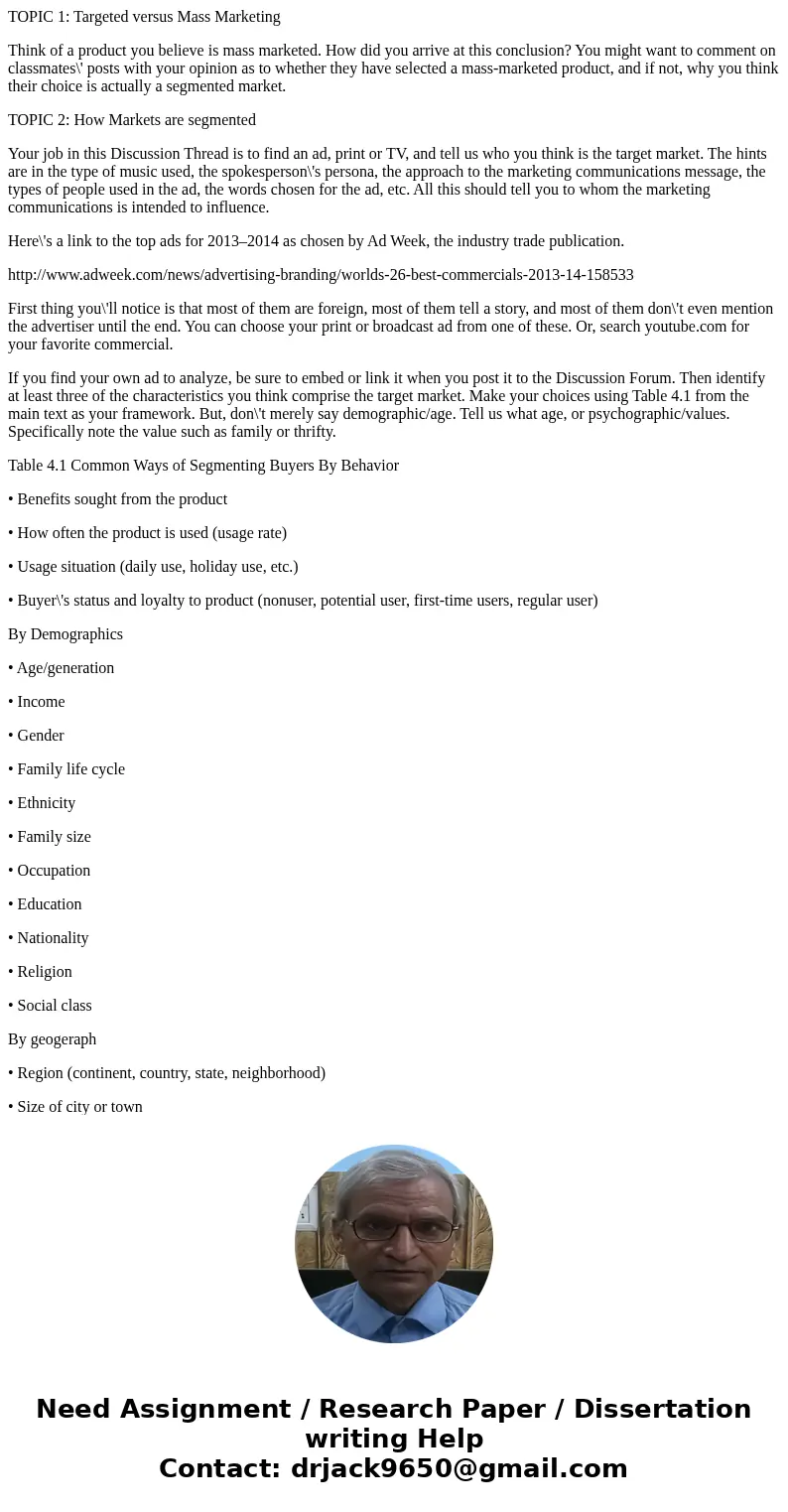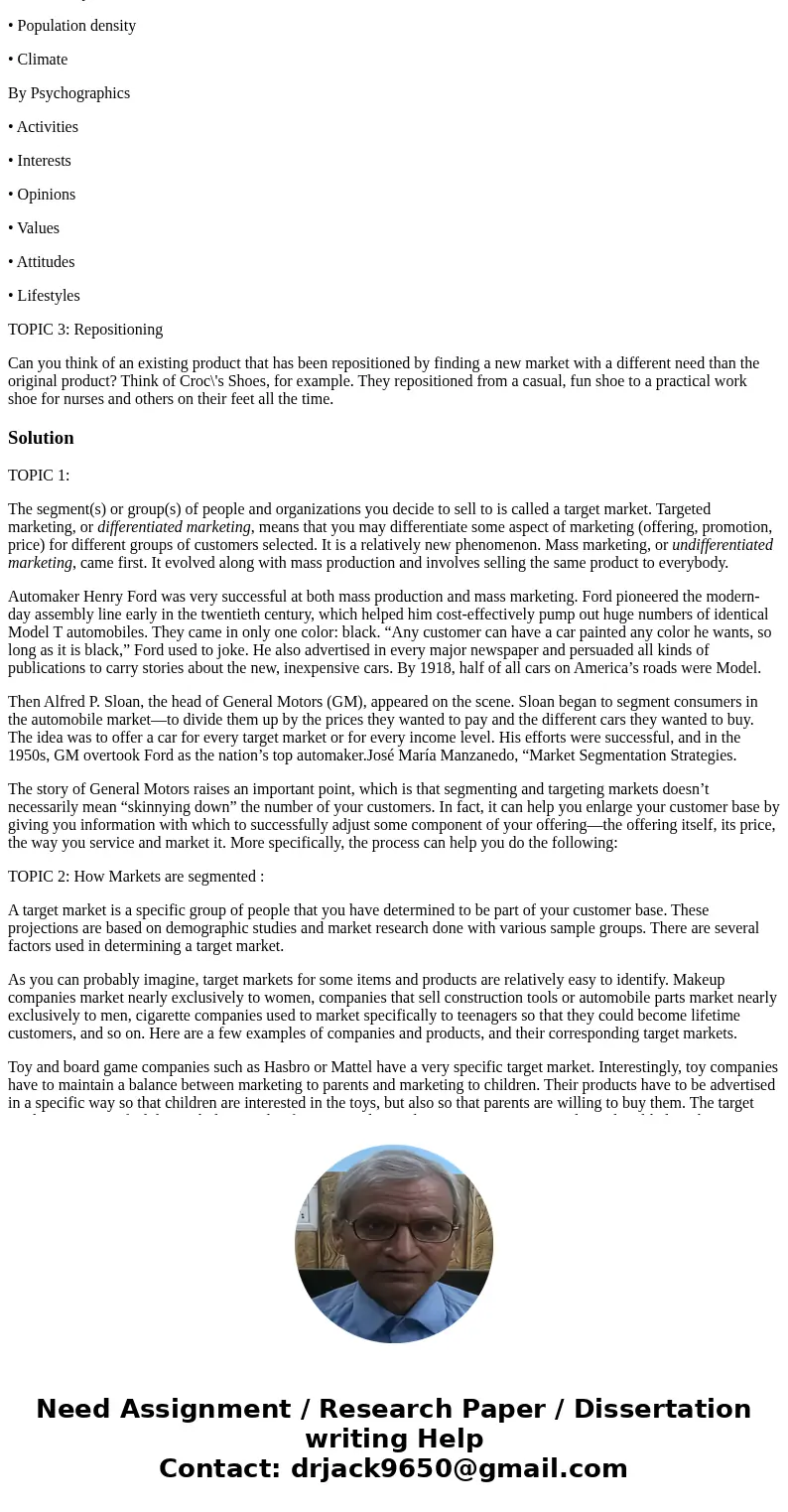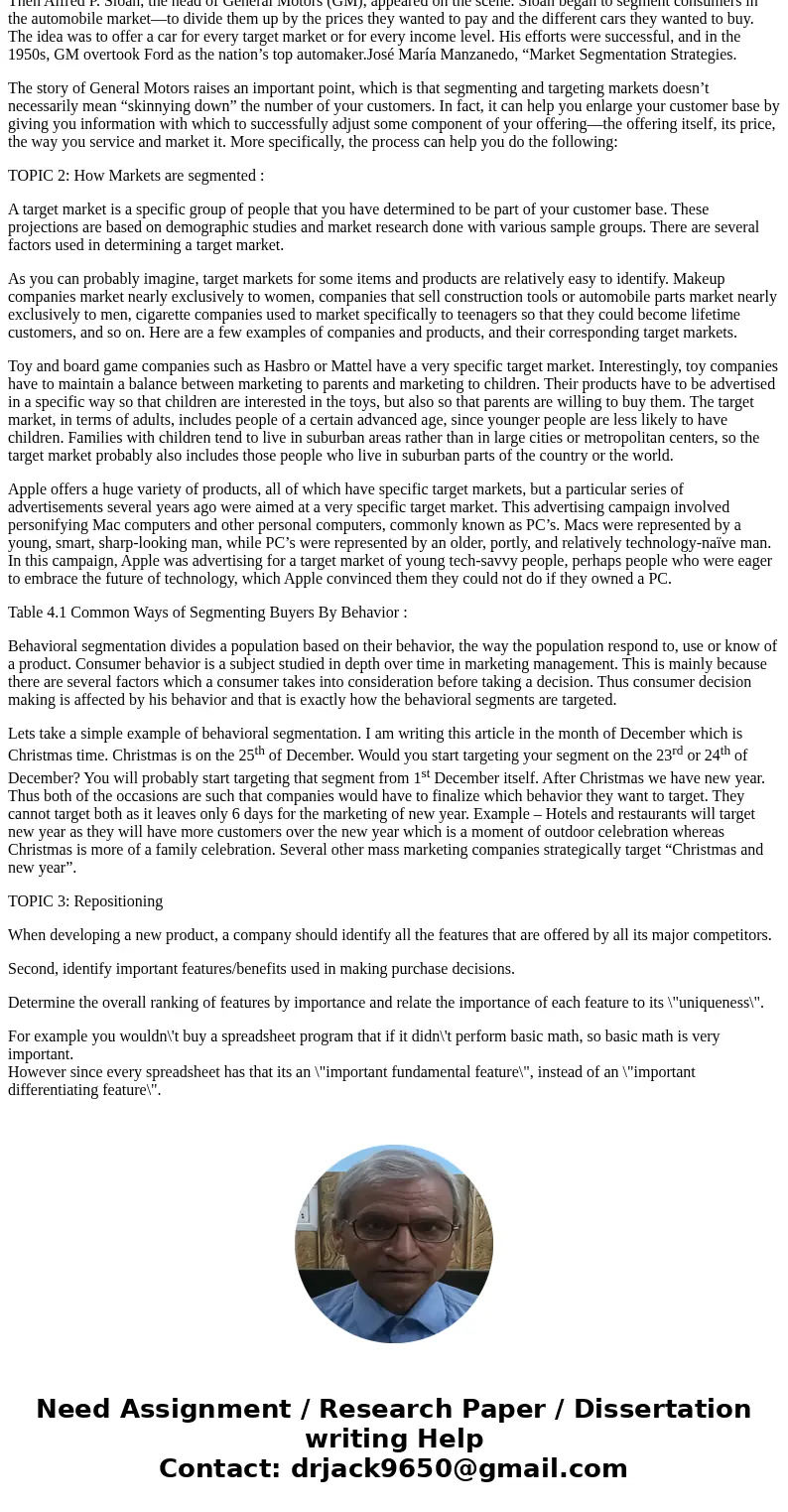TOPIC 1 Targeted versus Mass Marketing Think of a product yo
TOPIC 1: Targeted versus Mass Marketing
Think of a product you believe is mass marketed. How did you arrive at this conclusion? You might want to comment on classmates\' posts with your opinion as to whether they have selected a mass-marketed product, and if not, why you think their choice is actually a segmented market.
TOPIC 2: How Markets are segmented
Your job in this Discussion Thread is to find an ad, print or TV, and tell us who you think is the target market. The hints are in the type of music used, the spokesperson\'s persona, the approach to the marketing communications message, the types of people used in the ad, the words chosen for the ad, etc. All this should tell you to whom the marketing communications is intended to influence.
Here\'s a link to the top ads for 2013–2014 as chosen by Ad Week, the industry trade publication.
http://www.adweek.com/news/advertising-branding/worlds-26-best-commercials-2013-14-158533
First thing you\'ll notice is that most of them are foreign, most of them tell a story, and most of them don\'t even mention the advertiser until the end. You can choose your print or broadcast ad from one of these. Or, search youtube.com for your favorite commercial.
If you find your own ad to analyze, be sure to embed or link it when you post it to the Discussion Forum. Then identify at least three of the characteristics you think comprise the target market. Make your choices using Table 4.1 from the main text as your framework. But, don\'t merely say demographic/age. Tell us what age, or psychographic/values. Specifically note the value such as family or thrifty.
Table 4.1 Common Ways of Segmenting Buyers By Behavior
• Benefits sought from the product
• How often the product is used (usage rate)
• Usage situation (daily use, holiday use, etc.)
• Buyer\'s status and loyalty to product (nonuser, potential user, first-time users, regular user)
By Demographics
• Age/generation
• Income
• Gender
• Family life cycle
• Ethnicity
• Family size
• Occupation
• Education
• Nationality
• Religion
• Social class
By geogeraph
• Region (continent, country, state, neighborhood)
• Size of city or town
• Population density
• Climate
By Psychographics
• Activities
• Interests
• Opinions
• Values
• Attitudes
• Lifestyles
TOPIC 3: Repositioning
Can you think of an existing product that has been repositioned by finding a new market with a different need than the original product? Think of Croc\'s Shoes, for example. They repositioned from a casual, fun shoe to a practical work shoe for nurses and others on their feet all the time.
Solution
TOPIC 1:
The segment(s) or group(s) of people and organizations you decide to sell to is called a target market. Targeted marketing, or differentiated marketing, means that you may differentiate some aspect of marketing (offering, promotion, price) for different groups of customers selected. It is a relatively new phenomenon. Mass marketing, or undifferentiated marketing, came first. It evolved along with mass production and involves selling the same product to everybody.
Automaker Henry Ford was very successful at both mass production and mass marketing. Ford pioneered the modern-day assembly line early in the twentieth century, which helped him cost-effectively pump out huge numbers of identical Model T automobiles. They came in only one color: black. “Any customer can have a car painted any color he wants, so long as it is black,” Ford used to joke. He also advertised in every major newspaper and persuaded all kinds of publications to carry stories about the new, inexpensive cars. By 1918, half of all cars on America’s roads were Model.
Then Alfred P. Sloan, the head of General Motors (GM), appeared on the scene. Sloan began to segment consumers in the automobile market—to divide them up by the prices they wanted to pay and the different cars they wanted to buy. The idea was to offer a car for every target market or for every income level. His efforts were successful, and in the 1950s, GM overtook Ford as the nation’s top automaker.José María Manzanedo, “Market Segmentation Strategies.
The story of General Motors raises an important point, which is that segmenting and targeting markets doesn’t necessarily mean “skinnying down” the number of your customers. In fact, it can help you enlarge your customer base by giving you information with which to successfully adjust some component of your offering—the offering itself, its price, the way you service and market it. More specifically, the process can help you do the following:
TOPIC 2: How Markets are segmented :
A target market is a specific group of people that you have determined to be part of your customer base. These projections are based on demographic studies and market research done with various sample groups. There are several factors used in determining a target market.
As you can probably imagine, target markets for some items and products are relatively easy to identify. Makeup companies market nearly exclusively to women, companies that sell construction tools or automobile parts market nearly exclusively to men, cigarette companies used to market specifically to teenagers so that they could become lifetime customers, and so on. Here are a few examples of companies and products, and their corresponding target markets.
Toy and board game companies such as Hasbro or Mattel have a very specific target market. Interestingly, toy companies have to maintain a balance between marketing to parents and marketing to children. Their products have to be advertised in a specific way so that children are interested in the toys, but also so that parents are willing to buy them. The target market, in terms of adults, includes people of a certain advanced age, since younger people are less likely to have children. Families with children tend to live in suburban areas rather than in large cities or metropolitan centers, so the target market probably also includes those people who live in suburban parts of the country or the world.
Apple offers a huge variety of products, all of which have specific target markets, but a particular series of advertisements several years ago were aimed at a very specific target market. This advertising campaign involved personifying Mac computers and other personal computers, commonly known as PC’s. Macs were represented by a young, smart, sharp-looking man, while PC’s were represented by an older, portly, and relatively technology-naïve man. In this campaign, Apple was advertising for a target market of young tech-savvy people, perhaps people who were eager to embrace the future of technology, which Apple convinced them they could not do if they owned a PC.
Table 4.1 Common Ways of Segmenting Buyers By Behavior :
Behavioral segmentation divides a population based on their behavior, the way the population respond to, use or know of a product. Consumer behavior is a subject studied in depth over time in marketing management. This is mainly because there are several factors which a consumer takes into consideration before taking a decision. Thus consumer decision making is affected by his behavior and that is exactly how the behavioral segments are targeted.
Lets take a simple example of behavioral segmentation. I am writing this article in the month of December which is Christmas time. Christmas is on the 25th of December. Would you start targeting your segment on the 23rd or 24th of December? You will probably start targeting that segment from 1st December itself. After Christmas we have new year. Thus both of the occasions are such that companies would have to finalize which behavior they want to target. They cannot target both as it leaves only 6 days for the marketing of new year. Example – Hotels and restaurants will target new year as they will have more customers over the new year which is a moment of outdoor celebration whereas Christmas is more of a family celebration. Several other mass marketing companies strategically target “Christmas and new year”.
TOPIC 3: Repositioning
When developing a new product, a company should identify all the features that are offered by all its major competitors.
Second, identify important features/benefits used in making purchase decisions.
Determine the overall ranking of features by importance and relate the importance of each feature to its \"uniqueness\".
For example you wouldn\'t buy a spreadsheet program that if it didn\'t perform basic math, so basic math is very important.
However since every spreadsheet has that its an \"important fundamental feature\", instead of an \"important differentiating feature\".



 Homework Sourse
Homework Sourse